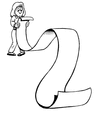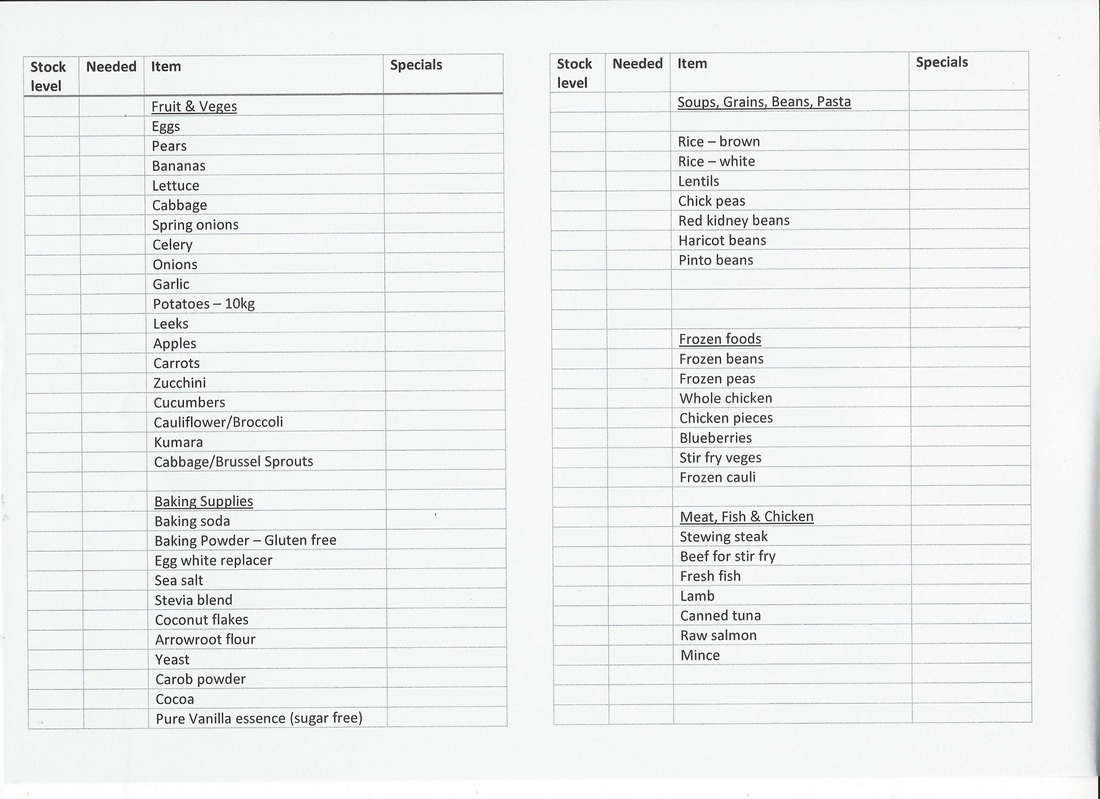Update (3/1/18): This particular attempt got sidetracked by life events, including the sudden death of my Dad. However, the intention remained, and I've just recently started a new version of this idea I'm calling the "Spend Next To Nothing Challenge." An explanation is HERE, and you can follow along with the daily blog posts HERE.
I’m about to begin an experiment: how long can we go without doing “proper” grocery shopping? I.e – spending only a minimal amount for a few essential perishables, but otherwise eating out of our pantry, fridge and freezers. Why would I want to do this?
Despite being crazy busy, I still tend to read a lot. And think a lot. And come up with a lot of ideas. I don't always have time to do anything with those ideas just yet, but every now and then I think "Wait! I really HAVE to do this!" So, lately I've been reading/thinking about such things as:
* How much is "enough"? How much stuff do we need in our house? How much food do we need stored up? How much time do we need to devote to certain activities? How much income do we need? And so on. I read a book called "More or Less - choosing a lifestyle of excessive generosity" by Jeff Shinabarger. Really makes you think! Definitely a recommended read!
* How to reduce our grocery spending? My fortnightly budget for food, non-food groceries, animal feed and so on is $500. And I generally go over it, which is NOT cool! Part of the problem right now is lack of planning - things have gotten complicated due to the multiple food intolerances, and the fact all of the family comes and goes with varying work hours and commitments, to the point it's hard to know who will be here when, and what foods I will have to exclude, which as made meal planning so complicated I keep putting it off. Our needs have changed since the boys left home, and some previously unrecognised food intolerances have become known. Our old menu plans no longer fit.
* How to find time to deal with the excess stuff that really needs to be decluttered? I KNOW I need to declutter again - busyness tends to lead to piles. But when the season of life is SO busy, it can be hard to get around to it.
* How to make room in my kitchen for the things that really need to be there? It's a small kitchen, with limited storage space. Which right now is packed.
* How to pay off some debt? The credit card has inched up again. I'm still paying off an interest-free hire purchase for my computer. And I'd like to clear those then work on eliminating the second mortgage.
* We really are privileged! Despite often feeling like I can't afford the cost of basic groceries, and despite all the times family members look in the fridge and declare "There is nothing to eat!" really, we are better off than about 98% of the world!! Seriously! We are also better off than some of our neighbours, I'm sure. How's this for an eye-opener? - go to http://www.globalrichlist.com/, enter New Zealand (or whatever country you are from), and put in the total amount of your annual income from ALL sources. It will calculate where you fit in the global scheme of comparative wealth, and show you a graphic of 100 people representing the world's population. How many are richer than you? In our case, only 1-2 people out of 100 are "richer" than us (our income fluctuates, so I did it for a couple of variations). And yet, by New Zealand standards, we are a low-income family. Even so, we're not truly badly off. We CAN make do with less!
* How much is "enough"? How much stuff do we need in our house? How much food do we need stored up? How much time do we need to devote to certain activities? How much income do we need? And so on. I read a book called "More or Less - choosing a lifestyle of excessive generosity" by Jeff Shinabarger. Really makes you think! Definitely a recommended read!
* How to reduce our grocery spending? My fortnightly budget for food, non-food groceries, animal feed and so on is $500. And I generally go over it, which is NOT cool! Part of the problem right now is lack of planning - things have gotten complicated due to the multiple food intolerances, and the fact all of the family comes and goes with varying work hours and commitments, to the point it's hard to know who will be here when, and what foods I will have to exclude, which as made meal planning so complicated I keep putting it off. Our needs have changed since the boys left home, and some previously unrecognised food intolerances have become known. Our old menu plans no longer fit.
* How to find time to deal with the excess stuff that really needs to be decluttered? I KNOW I need to declutter again - busyness tends to lead to piles. But when the season of life is SO busy, it can be hard to get around to it.
* How to make room in my kitchen for the things that really need to be there? It's a small kitchen, with limited storage space. Which right now is packed.
* How to pay off some debt? The credit card has inched up again. I'm still paying off an interest-free hire purchase for my computer. And I'd like to clear those then work on eliminating the second mortgage.
* We really are privileged! Despite often feeling like I can't afford the cost of basic groceries, and despite all the times family members look in the fridge and declare "There is nothing to eat!" really, we are better off than about 98% of the world!! Seriously! We are also better off than some of our neighbours, I'm sure. How's this for an eye-opener? - go to http://www.globalrichlist.com/, enter New Zealand (or whatever country you are from), and put in the total amount of your annual income from ALL sources. It will calculate where you fit in the global scheme of comparative wealth, and show you a graphic of 100 people representing the world's population. How many are richer than you? In our case, only 1-2 people out of 100 are "richer" than us (our income fluctuates, so I did it for a couple of variations). And yet, by New Zealand standards, we are a low-income family. Even so, we're not truly badly off. We CAN make do with less!
What I need to achieve is.....
So, right now, among other things I need to:
1) Cut my grocery spending
2) Create new menu plans with recipes that fit our food allergy issues and are flexible for our family's needs right now
3) Clear clutter from my kitchen
4) Figure out ways to use all those slightly more unfamiliar ingredients I've ended up with in the cupboard that I purchased intending to learn new recipes when we went gluten/sugar/mostly dairy-free. Use it or lose it.
5) Come to a place where my kitchen does not contain stuff I don't use, and where I have a menu plan, grocery lists and budget I can stick to, which provide us with a healthy and varied diet, suitable to our specific needs, but not extravagant. In fact, I want to spend as little as possible on the groceries in the long term.
1) Cut my grocery spending
2) Create new menu plans with recipes that fit our food allergy issues and are flexible for our family's needs right now
3) Clear clutter from my kitchen
4) Figure out ways to use all those slightly more unfamiliar ingredients I've ended up with in the cupboard that I purchased intending to learn new recipes when we went gluten/sugar/mostly dairy-free. Use it or lose it.
5) Come to a place where my kitchen does not contain stuff I don't use, and where I have a menu plan, grocery lists and budget I can stick to, which provide us with a healthy and varied diet, suitable to our specific needs, but not extravagant. In fact, I want to spend as little as possible on the groceries in the long term.
So the plan is....
And here's the crux of my current idea:
What if we didn't buy groceries for as long as possible, but instead lived on what we have on hand? How long would we last? And would doing so force me to get creative and come up with some new recipes and menu ideas?
I would have liked to buy NOTHING for as long as possible, but after discussion with the family (it helps if they are willing participants!) we decided that we needed SOME money for such things as milk and other essential items that might make all the difference between being able to make a reasonable meal or not. As I mentioned, our situation is complicated by food issues that actually affect our health. Most of us are gluten free, we choose to limit sugar, I cannot tolerate dairy products and my husband is better off without them, one daughter is allergic to cheese, cocoa, rice, most spices, MSG, Vit C, bananas, and needs to keep her iron levels down, I cannot have potatoes, eggs, most spices, or too much salicylates, but need to keep my iron levels up, another daughter is allergic to other foods and so on.
So we have decided to allow $50 per week for FOOD items. This is for 4 adults and 1 teenager plus assorted frequent visitors.
I'm also allowing $50 per week for non-food items (toilet paper, soap, shampoo, dishwashing liquid, cleaners etc), but my intention is to use as little of this as humanly possible, finding ways to make as many alternatives as possible with ingredients I have on hand. However, I need to be realistic about the fact that while my knowledge and intentions are high, my time is very limited right now.
And initially I'm allowing $50 per week for animal feeds and care. I know, sounds a lot. But we have currently 1 dog, 3 cats, 24 ducks, 24 chickens, and 20 sheep. The chickens and ducks account for a lot of it - most of those it is time to eliminate one way or the other. Sell them or eat them.
So, that means we will still be spending up to $150 per week, saving $100 per week. Actually more, if you were to count how much beyond our budget we've ended up spending lately! But in theory, $100 per week will be going towards reducing debt. More if I can spend less than outlined above!
How long will we last? How much will we save? Watch this space! For the purposes of blogging, I'm going to call this the $50 Grocery Challenge, as the main focus will be on spending less than $50/week on food (or $10 per person).
What if we didn't buy groceries for as long as possible, but instead lived on what we have on hand? How long would we last? And would doing so force me to get creative and come up with some new recipes and menu ideas?
I would have liked to buy NOTHING for as long as possible, but after discussion with the family (it helps if they are willing participants!) we decided that we needed SOME money for such things as milk and other essential items that might make all the difference between being able to make a reasonable meal or not. As I mentioned, our situation is complicated by food issues that actually affect our health. Most of us are gluten free, we choose to limit sugar, I cannot tolerate dairy products and my husband is better off without them, one daughter is allergic to cheese, cocoa, rice, most spices, MSG, Vit C, bananas, and needs to keep her iron levels down, I cannot have potatoes, eggs, most spices, or too much salicylates, but need to keep my iron levels up, another daughter is allergic to other foods and so on.
So we have decided to allow $50 per week for FOOD items. This is for 4 adults and 1 teenager plus assorted frequent visitors.
I'm also allowing $50 per week for non-food items (toilet paper, soap, shampoo, dishwashing liquid, cleaners etc), but my intention is to use as little of this as humanly possible, finding ways to make as many alternatives as possible with ingredients I have on hand. However, I need to be realistic about the fact that while my knowledge and intentions are high, my time is very limited right now.
And initially I'm allowing $50 per week for animal feeds and care. I know, sounds a lot. But we have currently 1 dog, 3 cats, 24 ducks, 24 chickens, and 20 sheep. The chickens and ducks account for a lot of it - most of those it is time to eliminate one way or the other. Sell them or eat them.
So, that means we will still be spending up to $150 per week, saving $100 per week. Actually more, if you were to count how much beyond our budget we've ended up spending lately! But in theory, $100 per week will be going towards reducing debt. More if I can spend less than outlined above!
How long will we last? How much will we save? Watch this space! For the purposes of blogging, I'm going to call this the $50 Grocery Challenge, as the main focus will be on spending less than $50/week on food (or $10 per person).
But what about preparedness?
Some of you are probably thinking, but why would you want to use up the contents of your pantry/food storage? What about disaster preparedness? What about having a cushion for hard times? What about storing up seasonal produce to eat the rest of the year? Are you just going to devour all of that? Is that truly wise, or thrifty?
First, I do believe in all of the above. However, a backlog of items that aren't getting used and might expire before they're used doesn't help anyone, and is a waste of space and money. Secondly, there is a balance point somewhere - storing sensibly, having a plan to use it, not being overwhelmed by too much stuff and nowhere to put it, planning meals to save time and money and so on. Right now things in our house are out of balance for various reasons. Clearing out some of the excess food stores and putting myself in a position that necessitates creative use of supplies is a useful thing for us, in the short term.
Also, my intention isn't to use up every scrap of stored food - particularly things like recently preserved/put up seasonal produce like tomatoes, marrows, pumpkins, garlic etc, I still want to have stores of when this challenge ends. My main focus is on using up all the miscellaneous bits and pieces and general pantry items.
And finally, I don't believe it's all about me and what I can do. I believe that God expects us to be wise and sensible, and to work hard and use the resources He provides as wisely as we can, to meet the needs of our families and to help others. But ultimately, our supply doesn't come from us - it comes from Him. I need to make changes to how things are running here, and I can work on that trusting that God is watching over us. That's a peaceful place to be.
First, I do believe in all of the above. However, a backlog of items that aren't getting used and might expire before they're used doesn't help anyone, and is a waste of space and money. Secondly, there is a balance point somewhere - storing sensibly, having a plan to use it, not being overwhelmed by too much stuff and nowhere to put it, planning meals to save time and money and so on. Right now things in our house are out of balance for various reasons. Clearing out some of the excess food stores and putting myself in a position that necessitates creative use of supplies is a useful thing for us, in the short term.
Also, my intention isn't to use up every scrap of stored food - particularly things like recently preserved/put up seasonal produce like tomatoes, marrows, pumpkins, garlic etc, I still want to have stores of when this challenge ends. My main focus is on using up all the miscellaneous bits and pieces and general pantry items.
And finally, I don't believe it's all about me and what I can do. I believe that God expects us to be wise and sensible, and to work hard and use the resources He provides as wisely as we can, to meet the needs of our families and to help others. But ultimately, our supply doesn't come from us - it comes from Him. I need to make changes to how things are running here, and I can work on that trusting that God is watching over us. That's a peaceful place to be.









 RSS Feed
RSS Feed
